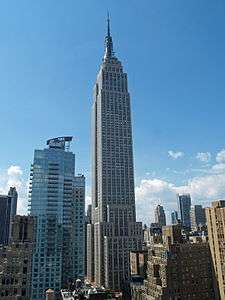Homer G. Balcom
Homer G. Balcom (1870–1938) was a structural engineer who was responsible for designing the Empire State Building. Balcom was the most prominent consulting structural engineer in America after World War I (WWI).[1]
Life and career
Balcom was born on February 16, 1870 in Chili, New York, the only child of Mahlon and Francis (Gage) Balcom. He earned his degree in civil engineering in 1897 from Cornell University.
In 1908 he opened his engineering consulting firm in NYC, Balcom and Darrow (later H.G Balcom and Associates). Its main offices were located at 314 Madison Avenue. On October 24, 1900, 30-year-old Homer Balcom married Gertrude McCrum. They would have one daughter, Gertrude Marie. She would often accompany her father to engineering and social functions.
During World War I he volunteered to engineer steel ships for U.S. government at the Hog Island, Pennsylvania shipyards. Because of his contributions, 122 military vessels were built for the war effort at Hog Island, the most of any shipyard by a wide margin.
Although most of his notable works are in USA he also designed buildings outside of the US. Examples include the Louvain University Library in Belgium, Devonshire House in London and Young Men’s Christian Association (YMCA) building in Jerusalem.
Balcom died July 3, 1938, at age 68. He had checked into the hospital four days earlier for a heart aliment. Masonic funeral services were held at his residence, 65 Calumet Avenue, Hasting-on-Hudson, and afterward he was buried at Sleepy Hollow Cemetery, Tarrytown, New York.
Legacy
In 1996, the ASCE Metropolitan Section (ASCE/Metro) established the Homer Gage Balcom Award: "To be presented to an individual who has demonstrated a lifetime of excellence in the structural engineering of buildings, along with advances in the state-of-the-art and a commitment to the advancement of the structural engineering profession."[1]
List of buildings

- Empire State Building
- David McCullough Bridge
- Rockefeller Center Plaza
- GE Building
- Waldorf-Astoria Hotel
- Nebraska State Capitol
See also
References
- 1 2 Weingardt, Richard G., P.E. (March 2009). "Homer G. Balcom: America's Post-WWI Structural Superstar". Structure. NCSEA. Archived from the original on July 8, 2014.
